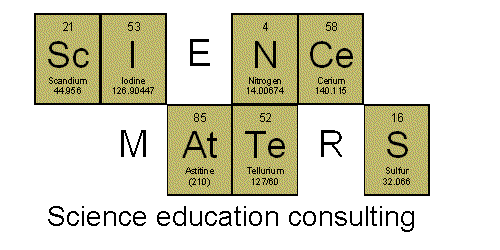The human brain, at full-size, is about the size of a full sheet of newspaper (or a pillow case), that's folded up to fit in your skull.
Keep your eyes open for a sheet of newspaper that
has a full page ad that has some writing, but a large white space. When
you're born, your brain already has a lot of information stored in it,
represented by the writing on the page. But there's also a lot of room
to learn more. That's the white space on the paper - the brain space
that's left to "write" on.
It's difficult to put numbers on how "full" one's brain is at birth and how much "room" there is for future learning, as the more you learn the more connections your brain makes. It appears that there's always room for more learning to take place and that the brain is never "full" (to our current knowledge).
Wednesday, June 26, 2013
Wednesday, June 19, 2013
Compound Story
Have your students write some "science fiction".
Each student chooses a compound (see below for some ideas) about which to write a story. While not a report, the story should include scientific information about the compound and include the compound's empirical and structural formulas.
Encourage your students to be creative in their writing and get into character - they could tell the story from the compound's point of view. They could "be" one of the elements within the compound. They could be reporting on a big news story involving the compound.
If students are having a hard time getting started, they may want to look up their compound to find out what it's used for and where it's found - what they learn may be the start of a story.
To make sure students don't get too carried away with the fiction aspect and forget the science part, you might wish to require them to use 12 (or whatever number you deem suitable) science terms. Some possibilities:
- metal
- nonmetal
- solid
- liquid
- gas
- chemical change
- physical change
- compound
- mixture
- periodic table
- family(ies)
- atomic number
- atomic mass
- stable
- unstable
- positive
- negative
- neutral
- valence electrons
- valence number
- empirical formula
- structural formula
- subscripts
- octet rule
- arms
- giver
- taker
- bonds
- share
- scientific name
- react
- reaction
- atom
- molecule
A list of compounds, to get you started:
- methane
- ethane
- propane
- butane
- octane
- acetylene
- benzene
- toluene
- carbon tetrachloride
- methanol
- ethanol
- propanol
- butanol
- carbon monoxide
- carbon dioxide
- calcium bicarbonate
- calcium oxide
- hydrochloric acid
- carbonic acid
- nitric acid
- water
- hydrogen peroxide
- hydrogen sulfide
- sulfuric acid
- ammonia
- nitric oxide
- nitrous oxide
- sodium chloride
- sodium nitrate
- sodium bicarbonate
- sodium hydroxide
- ozone
- silicon dioxide
- fructose
- sucrose
- potassium chloride
- citric acid
- vitamin C
- silver fluoride
- sodium fluoride
- silver chloride
Wednesday, June 12, 2013
The Expanding Universe: Balloon Model
On a flat, not-yet-inflated balloon, mark a series of points using a permanent marker. You may wish to make some of the points closer together and others farther apart.
These marks represent parts components of the universe. You may wish to have students measure the distance between points to make it more quantitative, of you may wish to just keep it a visual activity.
As you begin to inflate the balloon, the points mover farther and farther away from each other. The universe is expanding and distance between points is growing.
These marks represent parts components of the universe. You may wish to have students measure the distance between points to make it more quantitative, of you may wish to just keep it a visual activity.
As you begin to inflate the balloon, the points mover farther and farther away from each other. The universe is expanding and distance between points is growing.
Wednesday, June 5, 2013
Rate of Reaction: How Does Surface Area Affect the Rate of Reaction?
The combination of Alka-Seltzer and water produce a chemical reaction.
To see how surface area affects the rate at which this reaction takes place, you'll need two Alka-Seltzer tablets and two glasses of water.
Keep one of the tablets intact and crush the other tablet (crushing it into an actual powder would be even better than the pieces I've shown here - good chance to break out the mortar and pestle if you've got them).
Drop the whole tablet and the crushed tablet into the water (each tablet into its own glass of water) and observe the length of time it takes each reaction to finish.
To see how surface area affects the rate at which this reaction takes place, you'll need two Alka-Seltzer tablets and two glasses of water.
Keep one of the tablets intact and crush the other tablet (crushing it into an actual powder would be even better than the pieces I've shown here - good chance to break out the mortar and pestle if you've got them).
Drop the whole tablet and the crushed tablet into the water (each tablet into its own glass of water) and observe the length of time it takes each reaction to finish.
Subscribe to:
Posts (Atom)












